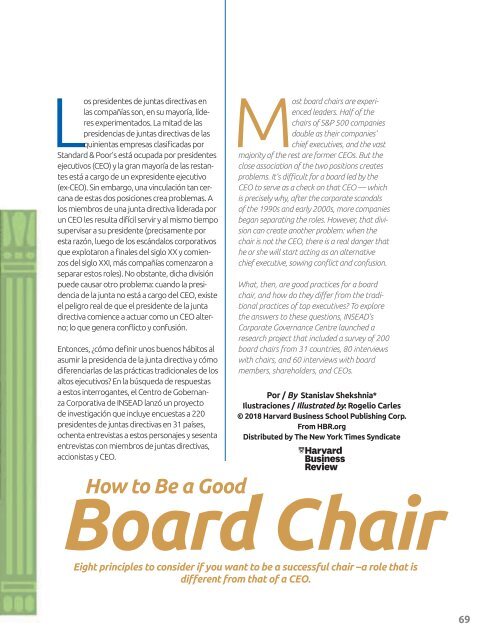You also want an ePaper? Increase the reach of your titles
YUMPU automatically turns print PDFs into web optimized ePapers that Google loves.
Los presidentes de juntas directivas en<br />
las compañías son, en su mayoría, líderes<br />
experimentados. La mitad de las<br />
presidencias de juntas directivas de las<br />
quinientas empresas clasificadas por<br />
Standard & Poor’s está ocupada por presidentes<br />
ejecutivos (CEO) y la gran mayoría de las restantes<br />
está a cargo de un expresidente ejecutivo<br />
(ex-CEO). Sin embargo, una vinculación tan cercana<br />
de estas dos posiciones crea problemas. A<br />
los miembros de una junta directiva liderada por<br />
un CEO les resulta difícil servir y al mismo tiempo<br />
supervisar a su presidente (precisamente por<br />
esta razón, luego de los escándalos corporativos<br />
que explotaron a finales del siglo XX y comienzos<br />
del siglo XXI, más compañías comenzaron a<br />
separar estos roles). No obstante, dicha división<br />
puede causar otro problema: cuando la presidencia<br />
de la junta no está a cargo del CEO, existe<br />
el peligro real de que el presidente de la junta<br />
directiva comience a actuar como un CEO alterno;<br />
lo que genera conflicto y confusión.<br />
Entonces, ¿cómo definir unos buenos hábitos al<br />
asumir la presidencia de la junta directiva y cómo<br />
diferenciarlas de las prácticas tradicionales de los<br />
altos ejecutivos? En la búsqueda de respuestas<br />
a estos interrogantes, el Centro de Gobernanza<br />
Corporativa de INSEAD lanzó un proyecto<br />
de investigación que incluye encuestas a 220<br />
presidentes de juntas directivas en 31 países,<br />
ochenta entrevistas a estos personajes y sesenta<br />
entrevistas con miembros de juntas directivas,<br />
accionistas y CEO.<br />
Most board chairs are experienced<br />
leaders. Half of the<br />
chairs of S&P 500 companies<br />
double as their companies’<br />
chief eecutives, and the vast<br />
majority of the rest are former CEOs. But the<br />
close association of the two positions creates<br />
roblems. Its dicult for a board led by the<br />
to serve as a check on that which<br />
is precisely why, after the corporate scandals<br />
of the 1990s and early 2000s, more companies<br />
began searating the roles. However, that division<br />
can create another problem: when the<br />
chair is not the CEO, there is a real danger that<br />
he or she will start acting as an alternative<br />
chief eecutive, sowing conflict and confusion.<br />
What, then, are good practices for a board<br />
chair, and how do they differ from the traditional<br />
ractices of to eecutives o elore<br />
the answers to these uestions, Is<br />
ororate overnance entre launched a<br />
research roect that included a survey of 200<br />
board chairs from 1 countries, 80 interviews<br />
with chairs, and 0 interviews with board<br />
members, shareholders, and CEOs.<br />
Por / By Stanislav Shekshnia*<br />
Ilustraciones / Illustrated by: Rogelio Carles<br />
© <strong>2018</strong> Harvard Business School Publishing Corp.<br />
From HBR.org<br />
Distributed by The New York Times Syndicate<br />
Board Chair<br />
How to Be a Good<br />
Eight principles to consider if you want to be a successful chair –a role that is<br />
different from that of a CEO.<br />
69



